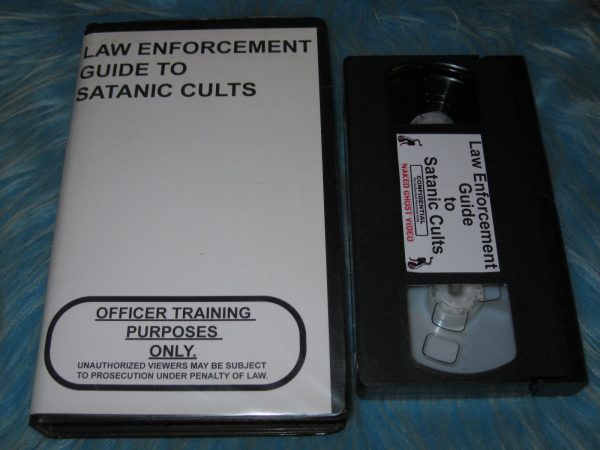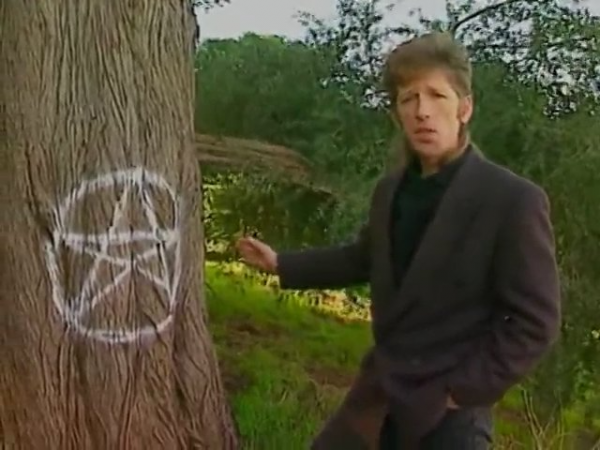In 1994, an independent producer made a short, earnest video featuring an eccentric cast of characters who were focused on a very specific paranoia. The tape was made to look like a TV news special. It opens with a cheap, Jerry Springer-era computer graphic of a gold pentagram set against a red brick wall. The video was called Law Enforcement Guide to Satanic Cults.
This video would come to be used by police departments across the nation as official training for their officers, showing them how to spot satanic crimes and how to put Satanists behind bars. But this video was once taken very seriously. Especially by police – who used it to convince their fellow officers that they were America’s first lines of defense in what we now call The Satanic Panic.
Satanic Panic
The Satanic Panic was based on conspiracy theories, misinformation, and straight up lies. But back in the 1980s and early 90s, that wave of paranoia and anxiety that swept across the US felt very real. The fear was that well-organized, secret satanic cults were lurking everywhere, corrupting America’s youth. Even worse, parents lived in terror that Satanists were kidnapping children and murdering them in gruesome occult sacrifices. There were dozens of documentaries and TV news specials produced on Satanism. Talk show celebrities made exposes stoking unfounded fears about demonic cults.
 These supposed deep dives into the dangers of devil-worshiping cults were wildly successful in terms of ratings. Americans couldn’t get enough of the wall to wall Satanic Panic coverage. But the Satanic Panic would have never become as big and ugly as it did without the misguided and ignorant actions of law enforcement. Gullible cops believed they were on the frontlines of an all-out war against a plague of demonic crime. Law enforcement did not shy away from this role. Since the early 1980s, when the panic began, police departments had been grooming cops whose job was to learn everything about demonic crimes. Some would proclaim themselves “Satanic experts.” They would teach classes on occult crimes to their fellow officers.
These supposed deep dives into the dangers of devil-worshiping cults were wildly successful in terms of ratings. Americans couldn’t get enough of the wall to wall Satanic Panic coverage. But the Satanic Panic would have never become as big and ugly as it did without the misguided and ignorant actions of law enforcement. Gullible cops believed they were on the frontlines of an all-out war against a plague of demonic crime. Law enforcement did not shy away from this role. Since the early 1980s, when the panic began, police departments had been grooming cops whose job was to learn everything about demonic crimes. Some would proclaim themselves “Satanic experts.” They would teach classes on occult crimes to their fellow officers.
Video Killed the Five-Pointed Star
And then in 1994, that law enforcement audience got exactly the kind of video it was looking for: a training tape about Satanic cults that was tailor made for cops. The video speaks straight to police with the message that Satanic ritual abuse is real, it is pervasive and horrific, and it’s hurting the most vulnerable people. According to the tape, cops are the ones to save us, and the tape promises to show them how.
There was already a built in market for something like this. As the go-to experts on satanic crimes, cops were the stars of the moment. They were the ones educating the public about the alleged ritual abuse crisis in which they also got to play the heroes. But there weren’t any videos made specifically to teach police how to spot Satanic crimes.
Devin finished editing the video in 1994. And then he made a very smart marketing move. Just to make sure he got the attention of police, he slapped a sticker on each VHS case that read “Officer Training Purposes Only. Unauthorized viewers may be subject to prosecution under penalty of law.”
It was a completely unenforceable and bogus warning. But it was meant to sell the idea that this was not just your average documentary. Even though anyone could purchase the tape through Lenny Magill’s gun video catalog, that sticker gave the tape the air of official police business.
 But this tape had a lot of the same problems as all the other fear mongering media of that era. First of all, it trains police to be on the lookout for so-called “dabblers”. These were people who did things that were supposedly Satanic-ish – like listening to heavy metal music, playing Dungeons and Dragons, or just being queer. Another problem with the video was that it featured someone claiming they were abused by Satanists as a kid. These kinds of repressed memory testimonies were widely discredited by the mid-1990s. Psychotherapists were criticized for coercing children into saying whatever they thought the adults wanted to hear. But the biggest issue with Law Enforcement Guide to Satanic Cults is how much it was probably just made up.
But this tape had a lot of the same problems as all the other fear mongering media of that era. First of all, it trains police to be on the lookout for so-called “dabblers”. These were people who did things that were supposedly Satanic-ish – like listening to heavy metal music, playing Dungeons and Dragons, or just being queer. Another problem with the video was that it featured someone claiming they were abused by Satanists as a kid. These kinds of repressed memory testimonies were widely discredited by the mid-1990s. Psychotherapists were criticized for coercing children into saying whatever they thought the adults wanted to hear. But the biggest issue with Law Enforcement Guide to Satanic Cults is how much it was probably just made up.
Satanists Work in Mysterious Ways
But the thing is – back in the 1990s, cops didn’t see any of this as just “goofing around.” The Satanic Panic stirred up a zealotry among police officers who became radicalized against Satanism. Particularly some Christian cops, who literally believed they were doing God’s work by hunting demons. And it wasn’t harmless.
All the lies, conspiracies, and satanic profiling – it all had real and tragic consequences. During the 1980s and 90s, nearly 200 people were charged with satanic ritual abuse crimes. Dozens were convicted and served long prison sentences. Some are still behind bars.
By the second half of the 1990s, a million holes had been poked in the Satanic Panic conspiracy theories. People stopped believing that daycare centers were fronts for child sacrifice ceremonies. At least – for the time being. And no one cared anymore if Satanic messages were hidden in rock music. Police departments around the country quietly stopped using the Law Enforcement Guide to Satanic Cults video. The tape disappeared from police training sessions, along with the phrase “satanic ritual abuse.”
It’s impossible to trace exactly how much Law Enforcement Guide to Satanic Cults was responsible for all the myths that ruined people’s lives during the Satanic Panic. But as an artifact of that era, it shows how conspiracies can easily balloon into the official story. And how easy it is to slap on a sticker with an official-sounding warning that seems to give these conspiracies the power and authority of law.
After the Break: Highway From Hell

Sometimes, associations with the devil appear in the smallest details. Ones you have to look carefully in old road atlases to find. Reporter Austin Cope has this story: “There’s a highway near where I grew up about half an hour’s drive from the New Mexico border. It runs through some of the more remote parts of the U.S. – northern New Mexico, southern Utah, and my own hometown of Cortez, in southwestern Colorado. Along the route, smooth tan sandstone cliffs and jagged brown volcanic rock formations rise up over the high desert. Hot sun and giant thunderclouds fill the sky in summer. Cold winds and dust storms blow over it in the winter and spring. The highway was called… US Route 666. Some locals called it triple six or the highway to hell. But most people I knew talked about it like a novelty. We had the “devil’s highway” running through our town.”





Leave a Comment
Share